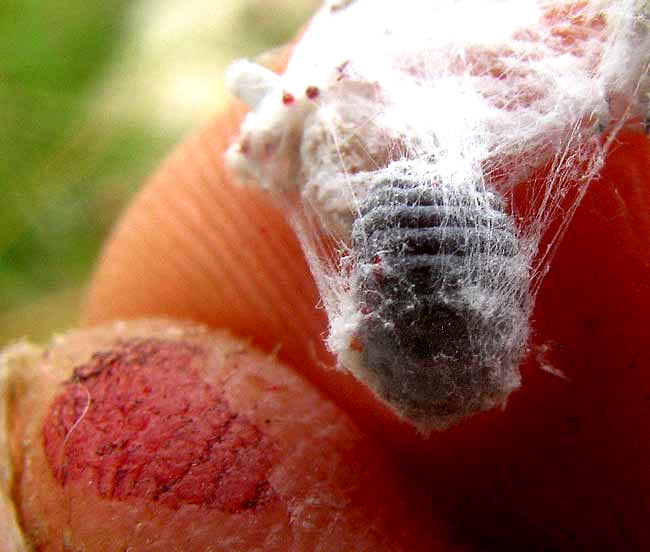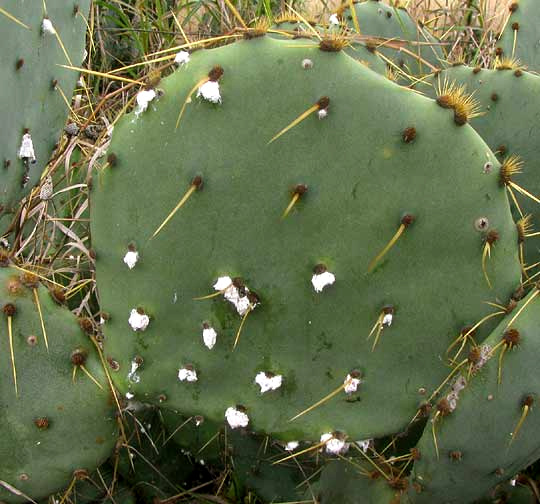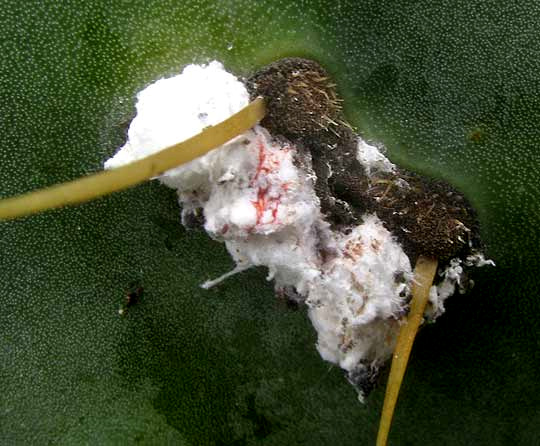Excerpts from Jim Conrad's
Naturalist Newsletter

from the November 17, 2013 Newsletter issued from the Frio Canyon Nature Education Center in the valley of the Dry Frio River in northern Uvalde County, southwestern Texas, on the southern border of the Edwards Plateau; elevation ~1750m (~5750 ft); N29.62°, W99.86°; USA
COCHINEAL SCALE INSECT
Pricklypear cacti are abundant here and occasionally you spot a plant whose spiny, green pads are spotted with small tufts of white, cottony fuzz, as shown below on a Texas Pricklypear, Opuntia engelmannii var. lindheimeri:

If you look closely at an individual tuft, often you see that the white cotton is stained here and there with red, as you see below:

If you carefully remove a tuft and pick apart the cottony fibers, inside you may discover a tiny insect like the one shown at the top of this page.
In that picture notice the blood-red stain on the tip of my thumb at the lower left. That resulted from a previous attempt to tease the insect from its cotton, when I was not careful enough, and the insect got a little squished. A bright red liquid issued from it.
All these details bring up a good story.
First of all, the insect is one of several species of the scale-insect genus Dactylopius. Probably it's the common species, DACTYLOPIUS COCCUS, but it's hard to distinguish the species, and other species also occur here. Scale insects in general vary dramatically in appearance; some hide beneath oyster-shell-like wax scales, and some others form cottony tufts like ours. Those with cottony coverings often are called mealybugs. The various coverings protect the insect from detection by predators, temperature extremes and, if they are on a plant in a garden or greenhouse, from insecticides sprayed on them.
I'm unsure whether the insect shown in our last picture is a larva or an adult female. That's because among scale insects the adult females continue to look as they did when they were larvae, a condition known as "neoteny." Adult males of most scale species have wings but they never feed, just try to have sex with a female, then die within a day or two. An upshot of neoteny among females is that females are immobile because they have no typical insect legs -- or eyes or antennae, for that matter. Being immobile must add some complications with regard to reproduction because often, especially late in the season, their offspring are parthenogenetically produced without the help of males. Their offspring are genetic replications of themselves.
So, an egg is deposited on a pricklypear, the egg hatches very quickly, and the first-instar, grub-like larva emerges. These first-instar larvae bear rudimentary legs and can crawl about; they're called "crawlers." On their heads they also bear long wax filaments that, when caught in the wind, enable the larvae to be blown to other cacti. Once they find a good place, they begin sucking the pricklypear's sap. After the first instar they lose their rudimentary legs and become fixed in their location for life -- throughout both their larval and adult stages -- and they develop the cottony material that covers them.
Certain mealybugs of the genus Dactylopius are famous less for their interesting life cycle than for the red juice they're filled with. Long before Europeans arrived, indigenous American cultures were using the red juice from Dactylopius mealybugs as a spectacularly red dye. The juice contains carminic acid which when mixed with aluminum or calcium salts make an exceptionally vibrant carmine dye known as cochineal.
During the early days of the conquest, Europeans paid high prices for cochineal dye; by 1600, cochineal had becom Mexico's second most valued export after silver. The dazzling splashes of red in paintings at that time by such artists as Rembrandt consist largely of smashed female Dactylopius mealybugs and eggs. Wikipedia's interesting page on cochineal dye is at https://en.wikipedia.org/wiki/Cochineal.
The main Dactylopius species producing cochineal is our Dactylopius coccus. Curiously, one population of this species occurs in South America while another is in Mexico. Recent genetic studies indicate that D. coccus originated in South America, but presumably was carried to Mexico by humans who valued it as a source of red dye.